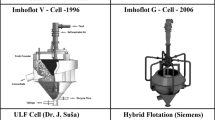Abstract
A symmetrically alternative rotating flow pattern was designed for flocculation process in order to produce large and dense flocs. The special effects of a symmetrically alternative rotating flow on the diameter and density of flocs were investigated. The results show that under the new fluid conditions, the primary particles on the outer part of the formed flocs may be cut down and the flocs contract at the end of the original rotating direction; then fluid changes its rotating direction, an opposite shearing is imposed to the flocs and makes some primary particles slide along the floc surface, leading to a denser floc; meanwhile, the broken and unflocculated particles on the trajectory may have opportunities to penetrate into or cohere to the flocs. Compared with the conventional rotating flow, the new-designed flow pattern can not only keep the floc size (even enlarge the floc diameter if a suitable flow is chosen) but also increase the floc density effectively.
Similar content being viewed by others
References
ZHONG Chun-chang. Designing of Water Treatment [M]. Beijing: Architectural Industry Publishing House of China, 1986. (in Chinese)
Tambo N, Hozumi H. Physical characteristics of flocs(II): strength of floc[J]. Water Res, 1979,13(2): 421–428.
MuÈ hle K, Domasch K. Floc Strength in Bridging Flocculation[M]. Berlin: Springer-Verley, 1990.
Camp T R, Stein P C. Velocity gradients and internal work in fluid motion[J]. J Boston Soc Civ Eng, 1943, 30: 219–237.
Kramer T A, Clark M M. Influence of strain-rate on coagulation kinetics[J]. J Environ Eng ASCE, 1997, 123: 444–452.
Thomas D N, Judd S J, Fawcett N. Flocculation modeling: a review[J]. Water Res, 1999, 33(7):1579–1592.
WU Dao-jie, XIA Fu-jun, TAN Feng-xun, et al. Discussing again the cause of the turbulent flocculation dynamics[J]. Water Treatment Technology, 2001,27(1):19–21. (in Chinese)
TANG Wen-hao, XIA Fu-jun. Research on the theory and application of eddy flocculation floatation[J]. Environmental Engineering, 2002,20(3):16–17. (in Chinese)
John G. The role of floc density in solid-liquid separation[J]. Filtration and Separation, 1998, 35(4): 367–371.
XU Ji-run, LUO Qian. The relative motion of solid particles and fluid in hydrocyclones, Part II: parameters of particles and fluid[J]. The Chinese Journal of Nonferrous Metals, 1998,8(4):691–694. (in Chinese).
Meakin P. Fractal aggregates[J]. Adv Colloid Interface Sci, 1988, 28:249–331.
Author information
Authors and Affiliations
Corresponding author
Additional information
Foundation item: Project (20276007) supported by the National Natural Science Foundation of China
Rights and permissions
About this article
Cite this article
Xu, Jr., Zhang, Yx., Xing, J. et al. Effects of symmetrically alternative rotating flow on flocculation. J Cent. South Univ. Technol. 10, 338–341 (2003). https://doi.org/10.1007/s11771-003-0035-5
Received:
Accepted:
Issue Date:
DOI: https://doi.org/10.1007/s11771-003-0035-5




